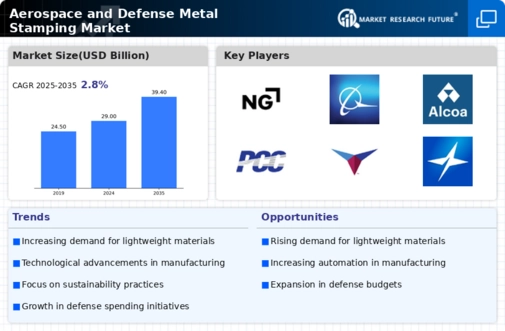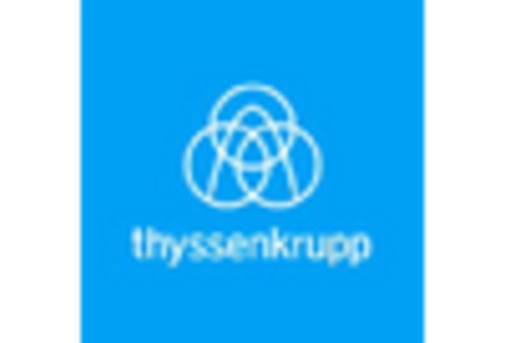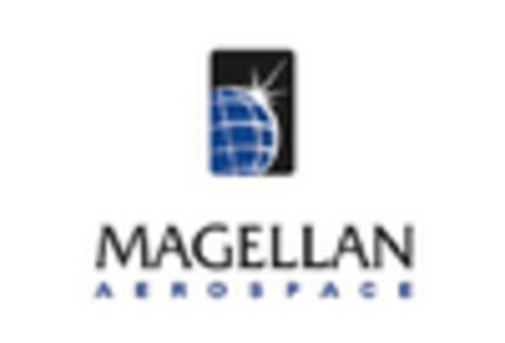Market Growth Projections
The Global Aerospace and Defense Metal Stamping Market Industry is projected to witness substantial growth in the coming years. The market is expected to expand from 29.0 USD Billion in 2024 to 39.4 USD Billion by 2035, reflecting a compound annual growth rate (CAGR) of 2.83% from 2025 to 2035. This growth trajectory is driven by various factors, including increasing defense budgets, technological advancements, and the rising demand for lightweight materials. The market's expansion indicates a robust outlook for manufacturers and suppliers within the aerospace and defense sectors.
Increasing Defense Budgets
The Global Aerospace and Defense Metal Stamping Market Industry is experiencing a boost due to rising defense budgets across various nations. Countries are allocating more resources to modernize their military capabilities, which includes the procurement of advanced aircraft and defense systems. For instance, in 2024, global defense spending is projected to reach approximately 29.0 USD Billion, indicating a robust investment in defense technologies. This trend is likely to drive demand for precision-engineered metal components, essential for the production of military aircraft and vehicles, thereby enhancing the growth prospects of the metal stamping sector.
Technological Advancements
Technological innovations in metal stamping processes are significantly influencing the Global Aerospace and Defense Metal Stamping Market Industry. Advanced manufacturing techniques, such as automation and robotics, are enhancing production efficiency and precision. These advancements enable manufacturers to produce complex components that meet stringent aerospace standards. For example, the integration of computer numerical control (CNC) technology allows for higher accuracy in metal stamping, which is crucial for aerospace applications. As these technologies continue to evolve, they are expected to attract investments, further propelling the market's growth trajectory.
Rising Commercial Aviation Sector
The expansion of the commercial aviation sector is contributing to the growth of the Global Aerospace and Defense Metal Stamping Market Industry. With increasing air travel demand, airlines are investing in new aircraft and fleet upgrades, which necessitate high-quality metal components. This trend is particularly evident in regions experiencing economic growth, where air travel is becoming more accessible. As airlines seek to enhance operational efficiency and passenger experience, the need for precision-engineered metal parts is expected to rise, thereby driving the metal stamping market forward.
Regulatory Compliance and Standards
Regulatory compliance and stringent industry standards are shaping the Global Aerospace and Defense Metal Stamping Market Industry. Manufacturers must adhere to rigorous quality and safety regulations, which necessitate the use of high-quality materials and precise manufacturing processes. Compliance with standards set by organizations such as the Federal Aviation Administration (FAA) and the European Union Aviation Safety Agency (EASA) ensures that metal components meet the required safety and performance criteria. This focus on compliance not only enhances product reliability but also fosters innovation within the metal stamping sector, as companies strive to meet evolving regulatory demands.
Growing Demand for Lightweight Materials
The demand for lightweight materials in the aerospace sector is a pivotal driver for the Global Aerospace and Defense Metal Stamping Market Industry. Manufacturers are increasingly utilizing advanced metals and alloys to reduce the weight of aircraft, which enhances fuel efficiency and overall performance. This trend aligns with the industry's focus on sustainability and cost reduction. As a result, the market is projected to grow from 29.0 USD Billion in 2024 to 39.4 USD Billion by 2035, reflecting a compound annual growth rate (CAGR) of 2.83% from 2025 to 2035. This shift towards lightweight materials is likely to create new opportunities for metal stamping companies.






















Leave a Comment